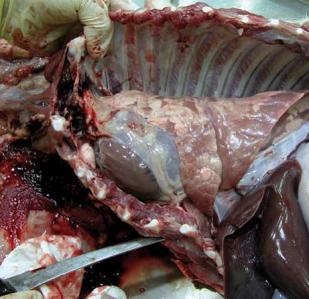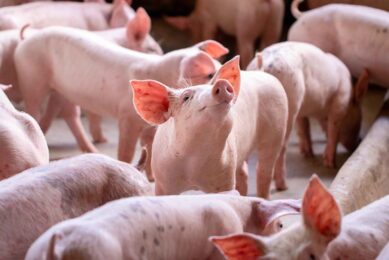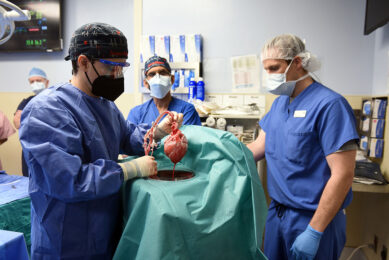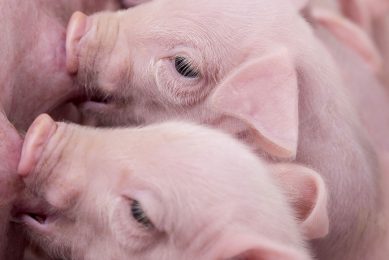The impact of PCV2 control on pig diseases

The impact of PCV2, even in sub-clinical circumstances, can be of significant economic importance, when taking into account its immuno-modulating properties. For that reason, combination vaccines are highly desired by the market for a number of reasons.
By Alex A.S. Eggen DVM, Intervet/Schering-Plough Animal Health, Boxmeer, the Netherlands
In the past few years, the pig industry has encountered an increasing number of disease problems with a marked increase in the use of medication, to the frustration of both farmers and veterinarians. It has been hard to identify the real reasons for these mounting problems. As is often the case, only the more expensive antibiotics tend to produce improvements.
Porcine Circovirus 2 (PCV2) vaccines, which have already been on the market for a number of years in certain countries, have altered the disease picture, but what does this mean? It is too early to draw firm conclusions, but certain signals, coming from both research and the field, cannot be ignored.
This article discusses the impact of the use of PCV vaccines on both Porcine Reproductive and Respiratory Syndrome (PRRS) virus and Mycoplasma hyopneumoniae (M. hyo) infections and their control.
PCV2 virus infection
Some excellent scientific work was published recently, elucidating the way in which PCV2 virus interacts with the immune system. In short, the pig, like man, has a very highly developed immune system in which several cells interact with each other to produce the required response when a pathogen enters the body.
Severe pneumonia in SEW pigs that were coinfected with PCV2 and M. hyo, 35 days post M. hyo infection and 21 days post PCV2 infection. This experiment has been published in Veterinary Pathology 41:624-640 (2004). Photo: courtesy of Iowa State University.
The system consists of different cells responsible either for cellular or for humoral (antibody) immunity, all of them having immature and developed stages. If there is a need to go further down the path of cellular or humoral immunity, the development from immature to mature is directed by very small molecules. These molecules all have specific names, but can be classified by their signalling function and grouped, for example, under ‘maturation inducing’, or ‘immuno-modulatory’, or ‘danger recognition’. The latter signals inform immune competent cells that a pathogen has entered the body and an immune reaction is needed.
When a pig experiences a PCV2 virus infection, the virus infects the dendritic cells which are important immune competent cells. They will usually remove any pathogens within 72 hours, but not with a PCV2 infection. In this case, the dendritic cells seem to tolerate PCV2 virus which can remain inside them for weeks. But PCV2 virus interferes particularly with the ‘immuno-modulatory’ signals. The virus delivers a very specific signal to the dendritic cells (and other antigen presenting cells) that impairs the ability of these cells to recognise the danger signals (McCullough, AASV 2007). So, the signals are still produced, but because they are not recognised as such by the target cells, a good immune response is not established.
PCV2 virus infection in the field can persist for long periods. Figure 1, from a field study in Germany, clearly shows how long a significant number of the pigs sampled remained positive for PCV2 virus. From the data represented above, underpinned by the research as well as information from the field, it can be concluded that pigs on a farm are undergoing a long term PCV2 virus infection and as a consequence are more susceptible to other diseases. This is entirely in line with most farmers’ and veterinarians’ experience of what actually happens on farm. What is more, it also raises the need to control PCV2 virus infections to a different level.
Concurrent infections
It might be deduced from the above discussion, or from information coming from the field, that if PCV2 virus is controlled, other diseases can be ignored. It is not that simple, of course. Most farms have had problems with a range of other pathogens, even before the introduction of PCV2 infection as we currently know it. Bearing in mind the nature of the virus, it is likely that when PCV2 virus does appear, there will be an increase in clinical expression of those diseases induced by other pathogens. Not only that, but opportunistic bacteria are all the more successful when the pigs’ defence mechanism is impaired by PCV2 virus. So controlling PCV2 virus infection may do no more than return a farm to its previous disease situation before the introduction of PCV2 virus.
So, for example, a farm with an Actinobacillus pleuropneumoniae (App) problem, which might have become more evident during the PCV2 outbreak, remains a farm with an App problem, even when PCV2 has been controlled. And similarly, data from North America have indicated that M. hyo and PRRS virus infection, in particular, continue to require attention, and that PCV2 control is not the whole solution.
Concurrent use of vaccines
As the vaccines against these three antigens (PCV2, M. hyo and PRRS) all need to be administered to young pigs at much the same age, companies are looking closely into the possibility of combining them.
This involves either giving them together in a single dose or at the same time at different sites, and various aspects of safety and efficacy need to be taken into account. Timing and dose are very important, of course, regardless of whether the vaccines are given alone or in combination. The differences between antigens in the degree of interference with vaccine take by Maternally Derived Antibodies (MDA) need to be carefully considered. And the possibility of direct interaction between antigens must not be ignored.
To confuse the picture still further, it has been clearly demonstrated that, with the PRRS/M. hyo combination, there are differences between vaccines – what is applicable for one combination of antigens might not be true for another, when the antigens have, perhaps, been derived from the same pathogens but of a different origin. This has been evident in several papers by Thacker and others, and a further paper will be published in 2009 on the same subject.
More and more information is becoming available that timing is important with PCV2 vaccines, and it is also true for M. hyo vaccines. Also it is becoming clear that vaccines differ in their ability to break through higher levels of MDA. The vaccine recently registered in the EU against PCV has a specific statement on the package leaflet about its unique property in this respect.
At the 2008 International Pig Veterinary Society (IPVS) Congress in Durban, data were presented from a trial which tested the combination of a M. hyo vaccine and a PCV vaccine (Porcilis M Hyo and Porcilis PCV respectively, both manufactured and marketed by Intervet/Schering-Plough Animal Health). The purpose of the trial was to show that there was no interference with the efficacy of either product when given at the same time. The efficacy was monitored in a double challenge model (with PCV2 virus and M. hyo). Figure 2 shows the results in the double-vaccinated pigs after the double challenge.
The results of the PCV2 challenge also showed a highly significant reduction in viraemia and faecal shedding in the vaccinated groups compared to the controls.
Source: Pig Progress Volume 25 nr 3











